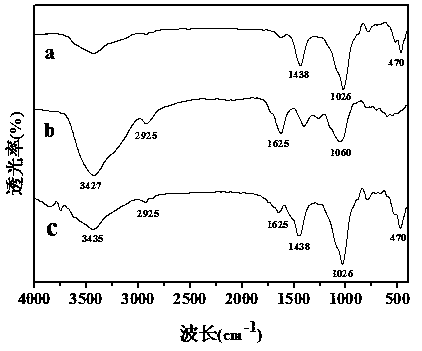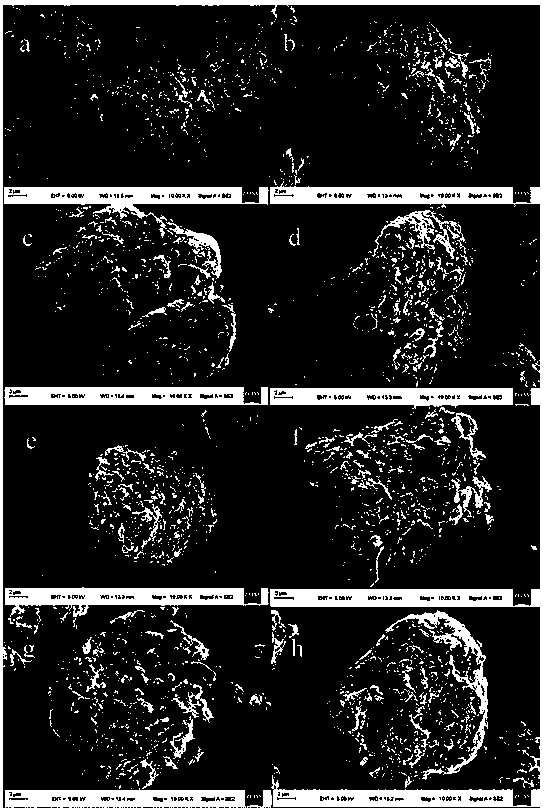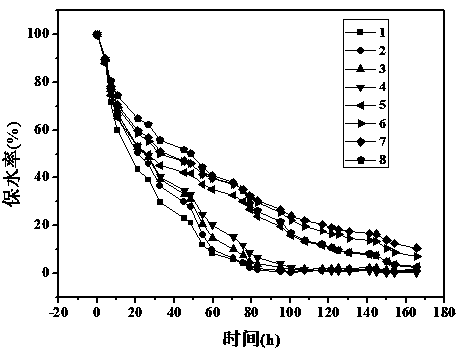Preparation method of inorganic clay-biological glue compound water-retention material
A technology of water-retaining materials and bio-glue, which can be applied to soil conditioning materials, organic fertilizers, chemical instruments and methods, etc., and can solve problems that are rarely reported
- Summary
- Abstract
- Description
- Claims
- Application Information
AI Technical Summary
Problems solved by technology
Method used
Image
Examples
Embodiment 1
[0041] Embodiment 1. Preparation of inorganic clay-flax gum (flax gum) water-retaining material
[0042] 1) After removing impurities, loess and laterite are mixed at a mass ratio of 1:0.2, dried, and crushed to 100-200 mesh;
[0043] 2) Add flax gum into deionized water at a mass ratio of 1:300, heat (45~65°C) and stir (300~500r / min, 60~120min.) to form a gel, and then add inorganic Clay (the mass of flax gum is 4.0~6.0%) is fully stirred (the speed is 300~600r / min, and the time is 30~60min.), mixed, granulated, and dried to obtain the inorganic clay-flax gum composite water-retaining material;
[0044] 3) Prepare the inorganic clay-flax glue water-retaining material into a viscous turbid liquid with a concentration of 0.75g / ml, and then spread it evenly on the upper layer of the soil and press it to form a soil-based water-retaining layer. At 70.5 hours, the water retention rate of the inorganic clay-flax glue water-retaining material is more than 31.08% higher than that of...
Embodiment 2
[0045] Example 2. Preparation of Inorganic Clay-Artemisia Gum Water-Retaining Material
[0046] 1) After removing impurities, loess and red clay are mixed at a mass ratio of 1:1, dried, and crushed to 100-200 mesh;
[0047] 2) Add Artemisia gum to deionized water at a mass ratio of 1:400, heat (45~65°C) and stir (300~500r / min, 60~120min.) to form a gel, and then add Inorganic clay (the mass of Artemisia gum is 4.0~6.0%) is fully stirred (the speed is 300~600r / min, and the time is 30~60min.), mixed, granulated, and dried to obtain the inorganic clay-Artemisia glue water-retaining material ;
[0048] 3) Prepare the inorganic clay-artemisia glue water-retaining material into a viscous turbid liquid with a concentration of 0.75g / ml, and then spread it evenly on the upper layer of the soil, and press it to form a soil-based water-retaining layer. At 72 hours, the water retention rate of the inorganic clay-artemisia gum water-retaining material was more than 28.81% higher than tha...
Embodiment 3
[0049] Embodiment 3, the preparation of inorganic clay-squat gum water-retaining material
[0050] 1) After removing impurities, loess and red clay are mixed at a mass ratio of 1:2, dried, and crushed to 100-200 mesh;
[0051] 2) Add inorganic clay-squat gum into deionized water at a mass ratio of 1:500, heat (45~65°C) and stir (300~500r / min, 60~120min stirring time) to form a gel , then add inorganic clay (mass of Tianjing gum is 4.0~6.0%) and stir well (rotating speed is 300~600r / min, time is 30~60min.) Mix evenly, granulate and dry to get inorganic clay-Azuna Glue composite water-retaining material.
[0052] 3) Make the inorganic clay-squat gum water-retaining material into a viscous turbid solution with a concentration of 0.75g / ml, and then spread it evenly on the upper layer of the soil, and press it to form a soil-based water-retaining layer. At 91.5 hours, the water retention rate of the inorganic clay-squat gum water-retaining material was more than 26.40% higher tha...
PUM
 Login to View More
Login to View More Abstract
Description
Claims
Application Information
 Login to View More
Login to View More - R&D
- Intellectual Property
- Life Sciences
- Materials
- Tech Scout
- Unparalleled Data Quality
- Higher Quality Content
- 60% Fewer Hallucinations
Browse by: Latest US Patents, China's latest patents, Technical Efficacy Thesaurus, Application Domain, Technology Topic, Popular Technical Reports.
© 2025 PatSnap. All rights reserved.Legal|Privacy policy|Modern Slavery Act Transparency Statement|Sitemap|About US| Contact US: help@patsnap.com



